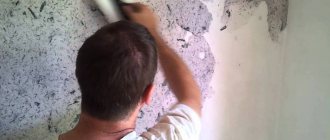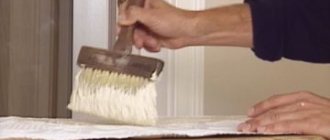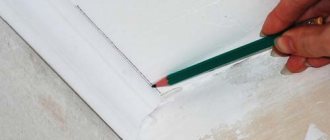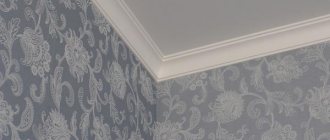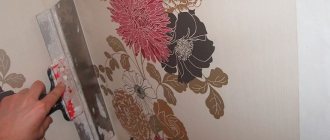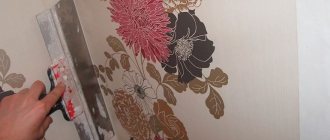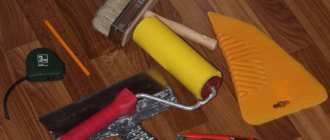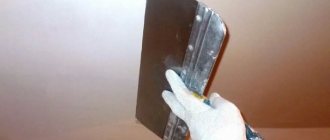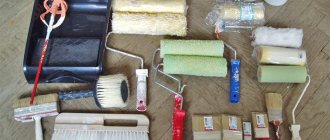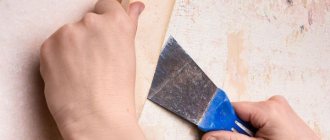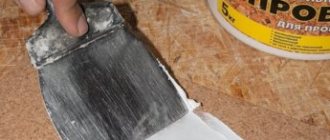Wallpaper backing is one of the most economical insulation materials for walls. In addition to retaining heat and sound insulation, such material is able to level the surface of the wall being glued. In addition, the substrate allows you to do without priming and leveling the walls, since it hides both cracks on them and irregularities.
If you do not allow excessively high humidity and temperature in the room, the substrate will prevent the formation of fungus. The substrate is moisture resistant, reliable and environmentally friendly. Quite durable and indestructible. The substrate can last up to ten years or more, depending on the manufacturer.
Wallpaper backing
The main function of the wallpaper backing
In addition to its main function, the base can also perform others, allowing you to increase the comfort in the room and its aesthetics.
- The base smoothes out uneven walls, facilitating further wallpapering.
- Due to the layer between the walls and wallpaper, thermal insulation increases.
- Some types of substrates additionally increase the sound insulation of walls.
- Due to the fact that the entire surface of the base has the same absorbent characteristics, the adhesive is distributed more evenly when applied. The same property ensures uniform drying of the glue over the entire surface and better adhesion.
- When applying wallpaper to a treated surface, it is easier to align their joints.
Thermal insulation base
2 types of materials can be used as a basis to prevent the entry of cold:
- putty;
- roll insulation.
Putty may contain sawdust or polystyrene; sometimes there are types with mineral fillers. But it takes longer to install as it needs to be applied first and then treated to make the wall smoother.
It is much easier to use a rolled insulation backing. It consists of two layers:
- polyethylene foam;
- foil.
This type of base is quite easy to attach to the wall, as it is self-adhesive. This means that even a child can work with it. Due to the presence of polyethylene foam, this substrate can also perform a soundproofing function and can also smooth out uneven walls.
Why do you need a wallpaper backing?
Thanks to the substrate it is possible to:
- Insulate the walls (if they cannot be insulated from the street).
- Protect the room from noise. This is relevant in high-rise buildings with thin partitions and low sound insulation. It is this soundproofing of the walls in the apartment that will improve the quality of life in the apartment.
- Waterproof the room. Thanks to the backing, you don’t have to worry about the pasted wallpaper, which will not be afraid of temperature changes and dampness. The moisture will remain in the walls and will not get on the wallpaper, so mold and mildew will not appear on them.
- Smooth out uneven walls. This material allows you to hide small unevenness in the walls (depressions and bulges), which will save your family budget on finishing the walls with putty, because you do not need to perfectly level them.
- Makes wallpapering easier. Simple installation and reasonable price of the material make this option the most optimal for decorating walls with wallpaper.
Therefore, if you are wondering, do you need a wallpaper underlay? It is best to stick it under the wallpaper, since the home should be not only beautiful, but cozy.
Bottom line
For each room, it is necessary to choose the most optimal type of wallpaper base so that it combines as many positive qualities as possible. After all, increased thermal insulation is not always required. And external sounds are often practically inaudible in brick houses.
But the use of a backing is still necessary, since it will not be possible to paste wallpaper onto plaster without it. In addition, without it, over time, all the flaws and stains that were on the concrete will appear on the wallpaper.
Is it always necessary to align walls with wallpaper?
Do-it-yourself primer and putty of drywall for all types of wallpaper
How to choose the right paint for non-woven wallpaper?
Purpose and characteristics of the material
The substrate is foamed polyethylene, covered on both sides with paper. In addition to paper, cork or non-woven backing is sometimes used, which have received excellent reviews from customers. This is an excellent material that has a high level of sound insulation and is a thermal insulation coating. The backing is designed for pasting any type of wallpaper directly onto it.
It has a number of advantages:
- it is durable;
- environmentally friendly;
- not susceptible to microorganisms;
- does not absorb moisture and prevents condensation from appearing on the walls;
- soundproof (has a high level of sound insulation).
Thermal and sound insulation are the main advantages of this material
It should be said right away that before gluing the substrate you need to know how to glue it correctly. First you need to prepare the walls. They need to be freed from old wallpaper. Old paint is also removed, and cracks and pits are leveled using putty or cement mortar. The surface is primed; PVA glue or any other wallpaper glue is suitable for this purpose.
The day before pasting the walls, you need to cut the material into pieces according to the size of the walls, let it rest and level out. Smooth sheets should be coated with glue on the inside and allowed to stand for five to ten minutes. Glue is used for gluing polystyrene or heavy wallpaper. The process of gluing the backing is similar to wallpapering. The same technology, only the sheets must be glued end to end.
Removing air bubbles from under the surface is done with a rubber roller. The seams must be sealed with paper tape or narrow paper tape. The next step is to wallpaper the walls, but you need to let the backing dry for at least 1-2 days.
The practicality of the substrate lies in the fact that it does not change its properties for twenty years (some manufacturers guarantee fifty years). This allows you to use the substrate for several repairs, covering it with new wallpaper. This insulating material will protect rooms from the effects of fungus and condensation for several decades, will increase soundproofing and heat transfer, and this will be especially noticeable in those rooms whose walls face the street or common corridors. In addition to all that has been said, the substrate also acts as a leveling material for uneven walls.
Application Features
The instructions for applying the substrate are very simple, just follow a number of rules:
- Remove any remaining old trim and loose pieces of plaster. Fill large cracks and chips with putty;
The wall before facing should be as clean as possible and free from damaged areas.
- Prime the wall before gluing the wallpaper under the backing;
The primer will ensure maximum adhesion of the substrate to the wall
- Cut the roll into sheets of the required sizes in advance;
All substrates are very easily cut into fragments of the desired dimensions
- Make sure the room temperature is around +10 degrees Celsius . At a lower temperature, the glue will not be able to gain sufficient strength; at a higher temperature, it will dry out too quickly, not having time to fix all areas of the finishing fabric;
- After applying the glue to the substrate, wait a few minutes until it is well absorbed, and only then apply the canvas to the wall. It is best to use PVA for this purpose, rather than ordinary wallpaper adhesives.
The backing sheet is applied a few minutes after treating its back side with glue.
Benefits of use
It is worth knowing some features of the use of the substrate and its advantages:
- Do not use the underlay in rooms with high humidity (bathroom, bathhouse).
- If there is already fungus on the walls, then you should not glue the substrate on it; first, ensure the complete destruction of fungal formations mechanically or with chemicals.
- Any gaps that appear between the sheets of backing can be sealed with paper strips adjusted to the size of the gap and PVA glue.
- Wallpaper underlay is not an ideal panacea for noise; there are more effective materials for sound insulation, but their installation requires special fastening, and they have a thickness of three to fifteen centimeters. This is where the substrate wins: it is an inexpensive material, easily sticks to the walls, and the work can be done by an unskilled person.
- Thanks to the materials used in the backing, it is easy to cut and the paper backing is easy to glue.
- The material is odorless, does not emit dust into the air, is environmentally friendly, can be used in children's rooms, and is absolutely harmless to human health.
- The ability to increase thermal insulation in places where the walls have low heat-insulating properties: dachas, block houses.
With the development of energy-saving technologies, the use of this material allows saving heat, although not in large quantities. In any case, savings are felt throughout the heating season.
Gluing technology
Pasting such soundproofing wallpaper will not take much time and effort. Gluing the backing is very easy. If you have worked with wallpaper before, then this work is also within your capabilities, the technology is similar. There is no need to carefully prepare the wall, unlike wallpaper. Here are the steps to apply the insulating material:
- There should be no previous material left on the wall. Large cracks and crevices must be smoothed over with plaster. The wall should be fairly dry, even and clean, without huge differences.
- Next, you need to cut the roll of substrate into sheets of the required length. The lightness of the material makes it easy to manipulate. The technology is almost identical to wallpaper gluing.
- For the Polyf type of substrate, we use glue on which heavy wallpaper is attached. We glue the non-woven linings using glue for non-woven wallpaper. When using it, apply glue only to the wall, not to the material. When mounting the polyethylene foam backing, we coat the wall and the backing itself with glue.
- Glue the strips seam to seam. For durable fastening, we reinforce the seams with paper tape. Let the walls dry for 72 hours, after which you can begin finishing.
By choosing the type of wallpaper underlay necessary for your case and installing it correctly, you will improve the quality of the finish, and with it, comfort. The sound-absorbing and heat-insulating properties of this material will protect you from harsh temperatures and noisy neighbors.
Main manufacturers
Before you start looking for where to buy underlayment, you should keep in mind that different types are made by different manufacturers. They differ in the thickness of the material, the quality and colors of the paper, and also in the selling price. We list the main brands offered for sale in Russia and the CIS countries:
- Ecoheat.
- Penolon.
- Polyf (some call it Poliform).
- Penohome.
- Globex.
To ensure that the subsequently pasted wallpaper does not change color or tone, you should choose a backing with white paper, since gray can appear on thin and light-colored wallpaper.
Like wallpaper, the backing is sold in rolls fourteen meters long and half a meter wide.
Is alignment necessary?
Wallpaper is still the most popular type of interior decoration. There are many types of materials on the construction market, from simple paper to silk-screen printing, non-woven and 3D. By gluing one of the types on the walls, be it plain paper or striped with silk thread, they should make the room cozy and the surface beautiful. To do this, the plane must be flat.
To level the plane, there are 4 materials, the use of which depends on the curvature and defects:
- wall curvature up to 2-3 mm - leveling with putty;
- if the walls are uneven 5 mm - use plaster;
- large curvatures of 10 cm - the use of plasterboard sheets;
- small errors - paper gluing.
Features of thermal insulation of walls using wallpaper backing
One of the types of wall insulation before wallpapering is roll insulation. It is performed using substrates about 8 mm thick, made on various bases:
- Expanded polystyrene backing. This material is produced in the form of rolls. To fix it on the surface of the walls, glue or a mixture containing gypsum fine-grained plaster is used. Wallpaper is glued to such a substrate using a special polymer-cement glue. Expanded polystyrene insulation with an outer layer made of cardboard has the best adhesion to wallpaper. Insulating walls with this material is quite effective, since it is reliable, absorbs noise and vibration well, is resistant to humidity and mold, but its thermal insulation properties are somewhat lower than those of polyethylene substrates, which will be discussed further. Thermo-Tap insulation has good reviews. The size of its roll is 10x0.5 m, the price of 1 m2 of material starts from 500 rubles.
- Polyethylene foam backing. The foam material consists of welded cells filled with air and enclosed between layers of paper. Therefore, any special composition for attaching the substrate to the base is not required. Wallpaper glue is quite suitable for performing the entire range of work. This substrate has excellent adhesion to any type of surface. Today, this rolled material is the most popular option as thin thermal insulation for walls. Polif insulation for wallpaper is generally accepted. It goes on sale in rolls of 0.5x14 m, material thickness - 50 mm, density - 30 kg/m3, thermal conductivity - 0.039 W/m*K, sound absorption - up to 22 dB, the price of a roll of Polif - 1200 rubles.
- Cork backing. It is impeccable in terms of ecology, has excellent thermal insulation properties and absorbs sound well. Its presentable appearance eliminates the need for external wallpaper. However, the moisture resistance of such insulation leaves much to be desired, so the cork substrate is often impregnated with moisture-repellent compounds - wax, for example. For ease of fixation on the walls, the back side of the cork backing is impregnated with glue. The material is sold in rolls of 5 m2, the price of 1 m2 is 400 rubles. and more.
- Backing combined with wallpaper. This material is wallpaper with insulation glued to the back side. For the production of such products, aluminum foil, synthetic fiber and the wallpaper itself are used. The installation costs of this insulation are minimal, but the material does not differ in variety.
Roll thermal insulation allows wallpaper to be repeatedly glued to its surface, and at the same time its characteristics remain unchanged. Substrates with a paper outer layer adhere tightly to the walls, while foil ones reflect heat well. Insulation under wallpaper can only hide minor flaws in the walls. If it is not possible to level the surface before installing it, it would be better to use cork insulation. It can hide almost all flaws, but special glue is required to attach the cork material.
Installation of the substrate
How to glue the backing to the wall:
- the surface is freed from wallpaper;
- remove water-based paint or whitewash;
- the recesses are leveled with putty or alabaster;
- The wall is primed with PVA glue
- 24 hours before sticking, the backing is cut and allowed to rest on a flat surface.
When working with non-woven backing, glue is applied not to it, but to the walls.
Tip: immediately remove excess glue from the joints with a napkin.
Pasting begins from the window and moves in a circle. At the junction of two walls, the sheets must be end-to-end - pasting a corner with one sheet with a bend is not allowed.
Properties of wallpaper bases
At the moment, there are many types of bases on the market that are applied under wallpaper, each of which has its own characteristics due to the material:
- paper;
- non-woven;
- cork;
- plasterboard or plywood;
- soundproof;
- thermal insulation.
Each type of premises requires its own substrate, most suitable for the structure of the walls and replacing their shortcomings.
Paper base
If you paste wallpaper on plaster, small irregularities may appear through them, which remain after applying this material to the wall. The simplest paper base will help eliminate them. It is also called lining wallpaper. This type of substrate perfectly levels out all minor surface imperfections.
A paper backing is also used if there is already wallpaper on the walls, but it is quite difficult to remove it. This material helps save time during repairs, since the thick paper that makes up the base reliably covers the pattern of the old wallpaper. And the stains on the “bare” walls after gluing it will become less noticeable.
Types of paper bases
The paper base is used for both textile wallpaper and vinyl. Used to work with ceilings and walls.
Main types of paper bases:
- compacted thick base - withstands heavy coating;
- thin - medium density and strength.
To work with paper backing, you must first clean the walls of old wallpaper, as well as, if necessary, putty and primer.
Non-woven base
Non-woven fabric has been on the market for a long time; wallpaper made from this material is the most popular. There are also substrates based on this material. They have the same properties as paper ones, but their strength is an order of magnitude higher.
It's all about the material itself. It is made from special, modified cellulose. It helps to increase not only strength, but also allows the walls to “breathe,” thereby increasing the drying speed of the glue and reducing the possibility of the wallpaper “sliding.”
Properties and characteristics of non-woven backing
Non-woven wallpaper is a non-woven, texture-free material with a base of long cellulose fibers. The top layer of the backing consists of polyester fibers. The function of the binding component is performed by acrylic polymer.
Drywall, OSB and plywood
If the walls have strong unevenness, then in order to hide them, it is necessary to use more serious types of substrates. They can be sheet materials with a width of 4 mm or more:
- drywall;
- plywood;
- OSB boards.
These types of materials will easily hide the imperfections of the walls, but to apply them you will need to build a frame on which they will rest. To construct it, you will need rectangular beams (logs) with a cross-section of 2x4 cm. If the surface has strong convexities, then their dimensions can reach up to 5x5 cm.
The beams are attached to the wall in the form of a lattice using screws and dowels. First, vertical logs are laid; they should be positioned so that when installed, the panel covers half of its width. Next, horizontal bars are applied; they must be placed between the vertical ones. The distance between horizontal joists can vary from 0.3 to 1 m, depending on how wide the bulges in the wall are.
Instead of wooden beams, you can use a U-shaped aluminum profile.
Next, sheets of material are placed on the logs. They are fastened using 16–19 mm self-tapping screws. The distance between the screws should be approximately half a meter, but no more, since if the fasteners are set too widely, the substrate may begin to “walk.”
After the panels are securely fixed to the wall, it is necessary to work out the joints so that they do not show through under the wallpaper. This can be done using putty.
Advice
Putty can create additional unevenness, which is why the joints can stand out, especially on light-colored wallpaper without or with a weak pattern. Therefore, it is recommended to combine the panel backing with other types, for example, paper.
You can also increase sound and heat insulation by filling the cavities between the wall and the substrate. This can be done using polyurethane foam. To do this, you need to make two holes in the panels in the space between the joists with a 6 mm drill. They should be located at the top corners of the empty space. Next, you need to pump foam into one of them. This must be done until the foam flows through another hole.
After sealing, you need to wait a day and then close the holes with putty. This solution will preserve heat and prevent extraneous sounds from entering the room.
Additional functions of wallpaper backgrounds
In addition to leveling the walls, the wallpaper backing can also serve as sound insulation. Also, a properly selected base serves as a good thermal insulator, helping to retain heat inside the living space.
In order to reduce the level of noise coming from outside, soundproofing substrates are used in the premises. They are made from foamed polyethylene. This material is located between two layers of durable paper.
This type of insulation is used as a substrate where it is impossible to install soundproofing structures. In addition, it has thermal insulation properties that are quite suitable for interior walls of buildings. Also, this type of base hides wall defects well due to its thickness.
How to make straight corners with your own hands?
If you need to straighten an external corner, i.e. the one that protrudes outward, it is better to use a perforated metal corner.
- To do this, apply a layer of putty or drywall adhesive to the walls on both sides of the corner.
- Then the metal corner is pressed into the adhesive.
- The excess mixture is removed, and the surface is then cleaned with sandpaper.
The inner corner is also leveled by applying putty:
- The correct joint is formed using a rule, performing movements first along one wall and then along the other.
- The applied layer of putty is sanded with sandpaper, and then a finishing layer is applied to eliminate minor flaws.
Ideally even corners are formed when using plasterboard panels.
Features and classification of sound insulation for wallpaper
When choosing materials for walls, it is important to take into account the installation process so that it is not difficult. It is important to know some of the intricacies of working with sound insulation. For example, there is a difference between sound absorption and sound insulation. Sound absorption is required when the source of noise is outside, and insulation helps get rid of sounds from the apartment that will not reach beyond the walls of the room. There are some features of sound insulation for walls:
- Comfort. External sounds will not annoy those living in the apartment.
- Soundproofing products for walls that already have a decorative surface go on sale, so no further finishing work is necessary.
- For those who like to listen to music, sit until night in a noisy company with a guitar, or for those who are learning to play a musical instrument, sound insulation will help minimize the noise that will go outside the room.
- They perform two functions: protect the room from noise and retain heat.
However, soundproofing walls with wallpaper also has some disadvantages. For example, to carry out installation, it is important to have free space. The second disadvantage is the cost, which is not always low. However, the costs will be justified. All that remains is to do all the work yourself to keep waste to a minimum. Let's consider the features of each type of sound insulation.
Sound-absorbing materials for walls
If you use such options, then it becomes possible to convert sound energy into heat. This allows you to dampen the intensity of reflected waves. This effect can be achieved by using polyurethane foam panels, liquid sound insulation, ZvukoIzol, and fiberglass boards.
Installation is simple: sound insulation is installed on the wall, and sheets of plasterboard are fixed on top of the frame. As for the thickness of such an insulation layer, it can reach 3.5 cm. It cannot be classified as thin. However, there is an exception, the thickness of which is 0.8 cm, this is cork, like a roll material.
Ultra-thin soundproofing materials for walls
They are quickly gaining popularity. Their peculiarity is their small thickness with high sound insulation qualities. This is a kind of soundproofing substrate that is glued under the wallpaper. This includes membranes and films that neutralize sound waves. The following products have some of the best characteristics and qualities:
- Texaund mineral membrane;
- Liquid noise insulation from Green Glue. Its viscous structure, formed after hardening, will not let any noise into the room.
The main advantages of such options are ease of use. In addition, due to its thinness, sound insulation under wallpaper will not take up useful space in the room, which is already very small. Now let's look at all modern types of sound insulation used for wallpaper.
Soundproofing materials for walls
Their peculiarity is to create a barrier to the sound wave. This option creates a barrier to sound, preventing it from entering or leaving the room. The best soundproofing materials for wallpaper for walls are the following options:
- Schumanet;
- Fonstar panels;
- Soundproofing;
- SoundGuard;
- ZIPS panels.
No less popular are decorative panels, filler or layered structure. They effectively retain sound and create a beautiful indoor interior.
All soundproofing products for walls under wallpaper come in different types: semi-rigid, hard and soft.
Effect after insulation
People planning to renovate their apartment doubt that insulation under wallpaper really “works.” First of all, the question is about its thermal insulation abilities. To prove the performance of roll materials, the following examples can be given:
- Polyfom has a thermal conductivity coefficient of 0.03 W/mK, which can be equated to brickwork more than 10 cm thick or a wooden covering 5 cm thick.
- Foil insulation 5-6 mm thick provides thermal insulation similar to a half-brick brick wall.
- Numerous experiments show that cork insulation 8-10 mm thick raises the temperature inside an unheated room by 3-4 degrees.
These examples perfectly show that the insulation under the wallpaper copes with its task. In addition, it must be taken into account that the cork creates a thermos effect. It helps keep the house cool in hot weather. To obtain complete comfort in the house, you should ensure a combination of wallpaper insulation with external wall insulation.
Wallpapering the base - prime the wall first
Priming the walls is one of the necessary conditions before starting work. The final result will depend on this initial stage. This stage of work should not be neglected.
To speed up the priming process, you can use special brushes, rollers, spray guns, and so on. Surfaces that absorb moisture abundantly are treated using specialized brushes. This way you can achieve deeper penetration of the soil mixture from the base of walls or ceilings.
There are several types of primer mixtures for wallpaper:
- Alkyd – prevents corrosion, gives durability and strength to the base. The alkyd base is resistant to temperature changes. Used on metal and ceramic surfaces.
- Acrylic is the most common type of primer mixture. Dries in 2-3 hours.
- Mineral – used for gluing wallpaper on any type of wall. It has good adhesion and has antiseptic properties.
- Pigmented - used exclusively for light, thin wallpaper. It gives uniformity to visible color defects and masks stains.
How to properly glue insulation to walls
Installation of insulation under the wallpaper is ensured by gluing it to the wall surface. The process technology is similar for all types of material. The difference lies in the choice of adhesive composition. Pasting is done in the following order:
Preparing the wall surface . The previous finishing coating is removed: paint, wallpaper, and old plaster. The wall is cleaned of dirt and dust.- Antiseptic treatment . The surface is carefully inspected for the presence of mold and fungal infection. Such areas must be treated with an antiseptic. Typically a solution of copper sulfate is used.
- Leveling the surface . Cracks and potholes are sealed. All irregularities are carefully removed. If necessary, leveling is carried out by plastering.
- Primer . It is necessary to ensure reliable adhesion of the insulation to the wall. The procedure is ensured by a deep penetration primer. It is best to use a ready-made composition. It is applied to the entire surface of the wall using a paint roller. In hard-to-reach places, use a paint brush.
- Uncover . Using a tape measure, the dimensions of the wall are measured, taking into account door and window openings, as well as other structural elements, such as niches or protrusions. If necessary, optimal use of each roll is ensured. It is cut into strips of the desired size with a sharp knife.
- Preparation of the adhesive composition . Produced in strict accordance with the manufacturer's instructions.
- Applying glue to the surface of the walls . After the primer has completely dried, glue is applied using a roller and brush. Its consumption is indicated in the instructions; these recommendations should be followed.
- Application of insulation . It is glued in strips and smoothed from top to bottom to remove air. The strips are laid end to end, without a gap. It is recommended to seal the seam with adhesive and seal it with masking tape. Excess material is cut off with scissors.
All subsequent operations are carried out only after the glue has completely hardened. This time is indicated by the manufacturer, usually it is at least 70 hours.
Installation should be carried out at an air temperature of at least 10 degrees, with a humidity of no more than 65%.
Do you use roll insulation under wallpaper?
Yes
No
Selection of adhesive composition
Different types of insulation require different adhesives. Expanded polystyrene insulation and polyfoam can be fixed to the wall using adhesives designed for heavy wallpaper. The most durable adhesives are those based on carboxymethylcellulose (CMC) and methylcellulose with the addition of PVA. Among domestic brands, KMC Super Extra and Moment Classic stand out. Foreign wallpaper adhesives are widely represented on the Russian market. Special mention goes to Kleo, Semin (France), Pufas and Metylan (Germany).
Cork insulation cannot be glued with regular wallpaper glue. Special adhesives are used for it. Adhesives received positive reviews: Pufas K12, Lacrysil, MultiFix, Wakol.
Criterias of choice
Which type is best to choose for internal wall insulation will depend on a number of factors related to the circumstances and wishes of the home owner, including:
- the degree of thermal conductivity and noise absorption that they hope to achieve;
- the usual level of humidity in the room where the walls are covered with wallpaper with a backing;
- the home owner’s willingness or unwillingness to accept the fact that the walls will be soft to the touch;
- the susceptibility of apartment residents to chemicals used for finishing that can cause an allergic reaction;
- financial capabilities of the owners.
How to properly and quickly level walls before wallpapering: recommendations
To quickly determine and level the surface, there are recommendations:
- Apply plumb lines - they will show how “filled” the plane is.
- Apply side light - it will show all the flaws that can be easily smoothed out with putty.
- After plastering, grout the surface and cover it with primer.
These simple tips will help you quickly identify defects and how to fix them.
To apply wallpaper, you need to level the wall. This will create a neat appearance and design of the room. To do this, they use methods that are less expensive and more labor-intensive, but practical. These tips will help you quickly move forward with quality work.
